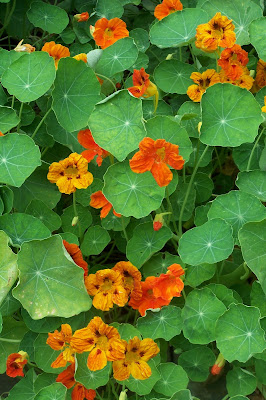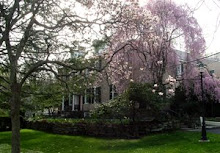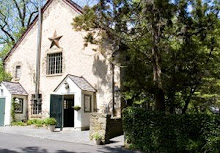Mums… check
Mother-nature’s yearly transformation of color…
 ... check
... checkOur property was almost an autumn wonderland.
All that was left... pumpkin pick-up day (our favorite)!
 This year, like years gone by, we went to Penn Vermont Fruit Farms, with a big pickup truck & bought 850 lbs of pumpkins. We really love to support local farms and are fortunate to have such a great network of growers in the area.
This year, like years gone by, we went to Penn Vermont Fruit Farms, with a big pickup truck & bought 850 lbs of pumpkins. We really love to support local farms and are fortunate to have such a great network of growers in the area.  Along with local decorations, we keep our food pantry stocked with plenty of what the season has to offer, apples, from an orchard just down the road at Manoff Market Gardens. From the spring to the fall, they have kept the kitchen supplied with fresh seasonal fruit.
Along with local decorations, we keep our food pantry stocked with plenty of what the season has to offer, apples, from an orchard just down the road at Manoff Market Gardens. From the spring to the fall, they have kept the kitchen supplied with fresh seasonal fruit.This fall, we refocused on a few tasks, making revisions to some projects already underway and finishing up others started in the summer.
Learning as we go, some projects inevitably require some changes. While our composting process is working well, its location left some desires. We wanted to make an effort to cut down on driving these machines carrying composting materials across the property.
 With that in mind, we relocated the new compost pile just off our secondary parking lot.
With that in mind, we relocated the new compost pile just off our secondary parking lot.  Not only does the new location save time & reduce gas consumption, it keeps our vehicles on previously established roads, thereby saving our fields from erosion.
Not only does the new location save time & reduce gas consumption, it keeps our vehicles on previously established roads, thereby saving our fields from erosion.(Driving repeatedly across grassy areas not only kills the grass, it compacts the soil, making it harder for other plants to get started. Then water run-off starts following the path, leading to further erosion. A steeply sloped hill, like the one we are located on, speeds up the soil erosion process substantially.)
With the pile more accessible, we can turn it more regularly, which speeds up the composting process. Lastly, we made a number of compost bins, allowing for piles in different stages of decomposition.

Our summer chicks grew fast and needed a new home, but where to start?
With the mindset of conserving, we save lots of materials that could “be used for something.” This goal of reuse has left us with a few piles of offcuts & leftovers, which from afar, don’t look like much. However, with a little creativity & imagination, they can really turn into a fun & functional project.
Using old fence posts as the foundation... 



 Because such a large quantity of water can be consumed here during events of up to 200 people at a time, we are making a concentrated effort to conserve water wherever we can.
Because such a large quantity of water can be consumed here during events of up to 200 people at a time, we are making a concentrated effort to conserve water wherever we can.













 We owe a huge thanks to the crew from
We owe a huge thanks to the crew from  No concrete was poured and no heavy machinery was used; it was all clever design, the right equipment and a hard working crew.
No concrete was poured and no heavy machinery was used; it was all clever design, the right equipment and a hard working crew. Using a 78ft by 21ft space), we are now creating a potentional of 25,000 kwh (kilowatt-hour) of energy annually. This offsets our electric consumption of the reception barn, where we hold many of our events. We also anticipate live tracking to monitor our solar production (which will be posted when available).
Using a 78ft by 21ft space), we are now creating a potentional of 25,000 kwh (kilowatt-hour) of energy annually. This offsets our electric consumption of the reception barn, where we hold many of our events. We also anticipate live tracking to monitor our solar production (which will be posted when available). We are happy that by producing solar power, we are positively impacting the world around us. We hope all of our customers share our excitement & our commitment to reducing our footprint.
We are happy that by producing solar power, we are positively impacting the world around us. We hope all of our customers share our excitement & our commitment to reducing our footprint. Now, not only will the sun lift our spirits, but it will also help power your event.
Now, not only will the sun lift our spirits, but it will also help power your event.

 We also painted some of the bedrooms...
We also painted some of the bedrooms...  ...the living room...
...the living room...  ... & the library with the Mythic paint.
... & the library with the Mythic paint.  We're happy with the outcome and feel good knowing we have created a healthier environment for our guests.
We're happy with the outcome and feel good knowing we have created a healthier environment for our guests.
